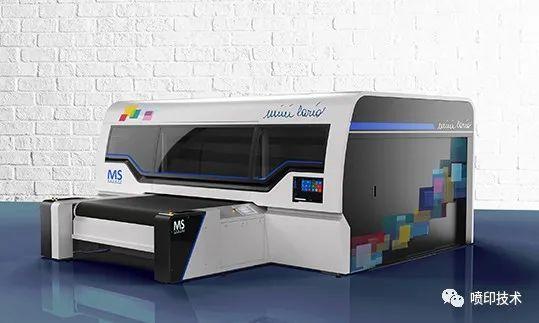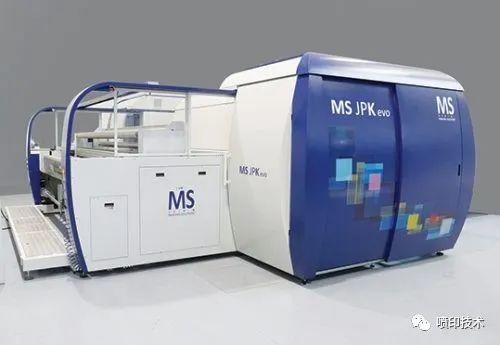Textile printing has changed dramatically compared to the beginning of the century, and MS has not been passively concerned.
The story of MS Solutions begins in 1983, when the company was founded. In the late 90′s, at the very beginning of the textile printing market’s journey into the digital age, MS chose to design only digital presses, thus becoming the market leader.
The result of this decision came in 2003, with the birth of the first digital printing machine and the beginning of the digital journey. Then, in 2011, the first LaRio single channel was installed, starting a further revolution within the existing digital channels. In 2019, our MiniLario project began, which represents another step towards innovation. The MiniLario was the first scanner with 64 printheads, the fastest in the world and a printing press ahead of its time.

1000m/h! The fastest scanning printer MS MiniLario debuts in China!
Since that moment, digital printing has grown every year and today it is the fastest growing industry in the textile market.
Digital printing has many advantages over analog printing. First, from a sustainability standpoint, because it reduces carbon emissions by around 40%, ink waste by around 20%, energy consumption by around 30%, and water consumption by around 60%. The energy crisis is a serious issue today, with millions of people in Europe now spending record incomes on energy as gas and electricity prices skyrocket. It’s not just about Europe, it’s about the whole world. This clearly highlights the importance of savings across sectors. And, over time, new technologies will revolutionize manufacturing, leading to increasing digitization of the entire textile industry, leading to improved savings.
Second, digital printing is versatile, a vital asset in a world where companies must provide fast order fulfillment, fast, flexible, easy processes and efficient supply chains.
Furthermore, digital printing matches the challenges facing the textile industry today, which is implementing innovative sustainable production chains. This can be achieved through the integration between the steps of the production chain, reducing the number of processes, such as pigment printing, which counts only two steps, and traceability, enabling companies to control their impact, thus ensuring cost-effective print output.
Of course, digital printing also enables customers to print faster and reduce the number of steps in the printing process. At MS, digital printing continues to improve over time, with a speed increase of about 468% in ten years. In 1999, it took three years to print 30 kilometers of digital fabric, while in 2013 it took eight hours. Today, we discuss 8 hours minus one. In fact, speed is not the only factor to consider when considering digital printing these days. Over the past few years, we have achieved production efficiencies due to increased reliability, reduced downtime due to machine failures and overall optimization of the production chain.
The global textile printing industry is also growing and is expected to grow at a CAGR of around 12% from 2022 to 2030. Amid this continued growth, there are a few megatrends that can be easily identified. Sustainability is for sure, flexibility is another. And, performance and reliability. Our digital presses are extremely reliable and efficient, which means cost-effective print output, easy reproduction of precise designs, maintenance and less frequent emergency interventions.
A megatrend is to have a sustainable ROI that takes into account intangible internal costs, benefits and external factors such as environmental impacts that were not previously considered. How can MS Solutions achieve a sustainable ROI over time? By limiting accidental breaks, reducing wasted time, increasing machine efficiency, by ensuring high-quality performance and by increasing productivity.

At MS, sustainability is at our core and we do our best to innovate because we believe innovation is the starting point. In order to achieve more and more sustainable development, we invest a lot of energy in research and engineering right from the design stage, so that a lot of energy can be saved. We also put a lot of effort into optimising the durability of the machine’s vital components by continually updating and using high-quality materials to minimise machine breakdowns and maintenance costs. When it comes to optimizing our customers’ processes, the opportunity to get the same long-lasting print results on different machines is also a key factor, and for us this means being able to be versatile, a key feature of ours.
Other essential features include: As a full range of printing consultants, we pay the utmost attention to every stage of the process, which includes assisting with the traceability of the printing process, as well as providing reliability and long life for our presses. A highly diversified product portfolio with 9 paper presses, 6 textile presses, 6 dryers and 5 steamers. Each one has its own characteristics. In addition, our R&D department is constantly working on our product portfolio to achieve maximum efficiency levels, with the aim of achieving a good balance between productivity and shortening time to market.
All in all, digital printing seems to be the right solution for the future. Not only in terms of cost and reliability, but also offers a future for the next generation.
Post time: Nov-02-2022
